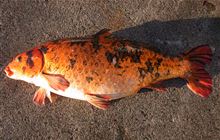Pest fish barrier helps control spread of koi carp at Lake Ruatuna
Archived content: This media release was accurate on the date of publication.
Introduction
A new barrier has been installed at Waikato’s Lake Ruatuna to prevent the spread of the invasive pest fish koi carp.Date: 21 June 2021
The barrier – at one of Waikato’s most important freshwater ecological restoration projects – results from the Living Water project, the conservation partnership between Fonterra and DOC.
Koi carp are an introduced pest fish resembling giant goldfish and are widespread across the Waikato. An unwanted organism and noxious fish, koi are a serious ecological threat to the health of freshwater ecosystems.
The Lake Ruatuna grill barrier is designed to prevent access of adult koi carp upstream and serves as a final barrier between the lake and the pest fish during flooding events. The grill bar has spacings of 30mm allowing movement of native fish like tuna while also preventing adult carp passage.
Dion Patterson, DOC’s Waikato Peat Lakes Site Lead, says there are limited options available to manage koi carp, and barriers act as a last line of defence to help control the spread of this pest fish.
“Koi are like the possums of freshwater,” says Dion Patterson. “They’re very hard to eradicate and are highly destructive. They feed like vacuum cleaners, sucking up anything in their wake and blowing out anything they don’t eat – which isn’t much.”
Koi feed on insects, fish eggs, small fish, plants and almost any other organic matter. Their manic feeding stirs up the bottom of waterways, further degrading water quality. And unfortunately, koi thrive in degraded water.
“Koi carp have not been detected in Lake Ruatuna so maintaining this ‘koi free’ status is a priority for this site.”
Catfish, rudd and goldfish are present in the lake and the ongoing control through net fishing is intended to reduce their numbers. The work of staff involved in pest fishing at Lake Ruatuna acts as a surveillance should koi somehow find their way into the lake.
The design, consultation, consenting process and construction has taken several years and water levels at the outlet had to be suitable for installation.
“The design and functionality of this trap looks great, and we are thankful to the expertise consultant John Gumbley has in this field. The trap will require ongoing checks for blockages and potentially weed clearance,” says Dion Patterson. “Maintenance will be scheduled as part of regular predator trapping lines DOC Rangers and volunteers do around the lake."
Koi must be killed immediately if caught. Check, clean and dry all gear that comes into contact with water when moving between waterways to prevent the spread.
Contact
For media enquiries contact:
Email: media@doc.govt.nz

